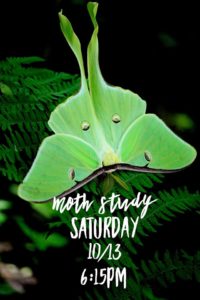ODL Classes 
The Outdoor Learning (ODL) classes this trimester (grades 1, 4, and 6) have learned about the feeding habits of the gray and red squirrels. They have also learned about the Goldenrod Gall Moth, reviewed the fabulous trees on our campus, and continue to track and stalk creatures living in our forest, field, and edges of our buildings. We have been finding lots of interesting moths and insects at the back entrance to Hanshi each morning (overnight light helps attract them). This month we will explore the very “cool” moss bugs (larvae of the green lacewing) on the bark of the locust trees near the crosswalk. We will also make use of our binoculars to view migrating hawks or
“kettling” black or turkey vultures.
Bagworm, Webworm, or Tent Caterpillar?
At the beginning of the school year, I received an email from a concerned parent about an insect or a caterpillar affecting one of her trees at home. Hum? With a little bit of research we uncovered some info on three confusing creatures. Bagworms make dangling, brown ornaments from the branches of evergreens. They feed all summer and then make these individual silk cases covered with
leaves from their last meal. We have found them on the white pines and cedar trees in the front of Hanshi. The Eastern Tent Caterpillars occur early in the spring when the larvae build a web or “tent” at a fork in a tree. The caterpillars feed on crabapple, hawthorn,
mountain ash, flowering cherry, and other shrubs form the rose family. The Fall Webworm occurs late in the season becoming noticeable in the August/September. They build big protective nests at the end of branches. The tent gets bigger as the caterpillars
eat leaves. They feed on 120 species of deciduous trees. Tearing or pruning the webs and their resident caterpillars out of the tree can also control tent caterpillar and fall webworm. Obviously be aware of maintaining the shape and health of the tree by not removing large branches. Although it is aesthetically unpleasing,late season defoliation of deciduous trees as with fall webworm is usually not life
threatening for the tree.
Moth Night
Ready for an adventure? This summer I worked at Belleplain Forest where we held two evening Moth Nights. Moths are the silent majority. For every one butterfly species there are 9 species of moths! They come in many shapes, sizes, and colors. On this coming Saturday night at 6:30 pm at Belleplain State Forest (40 minute drive from Mullica Hill), we are having a third moth night. Joining us will be the renowned “mother” – Dale Schweitzer (former curator at Yale and Harvard) – a local resident who will help us identify these amazing creatures. There is no cost. If you are interested in this kid friendly event, see me for more details. Why not come camp at the forest and attend
moth night? You’ll love the experience and so will your kids!
Migration
Recently my wife and I went to Cape May Point to experience the amazing migration of raptors, butterflies, and dragonflies. I mentioned this last year! We all live along the eastern migration flyway where both the spring and fall migrations are memorable! I highly recommend a visit to the point to experience the phenomena. We saw multiple species of hawks zooming by the hawkwatch platform (particularly the Peregrine Falcons) with very helpful Cape May Bird Observatory hawk watchers to help identify the species. Taking a walk along the beach at the point we saw hundreds of monarchs clinging to and feeding on the seaside goldenrod. Some of them could have
been from our school. Boy, was it a great year for monarchs at Friends School! We also saw many migrating dragonflies (common green darners, black saddlebags and some Carolina saddlebags getting ready to launch across the daunting looking DE Bay! Also don’t forget Hawk Mountain (just east of Allentown) – world famous fall hawk event happening right now. The day after a storm front passes and we get those north or northwest winds is the best time to experience the migration of these creatures. See me if you have any que tions about these special places. Your kids will love it! FYI – If you are interested in the monarchs check out the Monarch Monitoring Project BLOG and Facebook page (Cape May).
Eager
The other day I was passing around a beaver skull and a beaver stick with my little Pre-K Spanish class. The kids had lots of questions about beavers. Yesterday as I visited my local library, I saw a book on the new arrivals display – Eager: The Surprising, Secret Life and Why Beavers Matter by Ben Goldfarb. The book starts of with how beavers are the environmental Swiss Army knives, capable of tackling just about any ecological dilemma. I’ll keep you posted on what I learn. Have you seen a beaver lately? They are here in South Jersey!



Follow and Contact Us